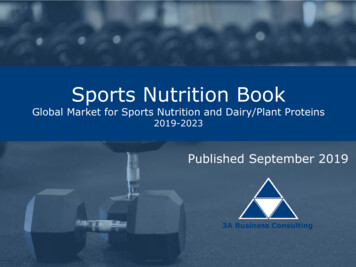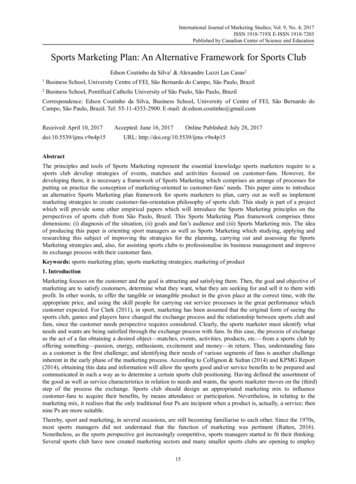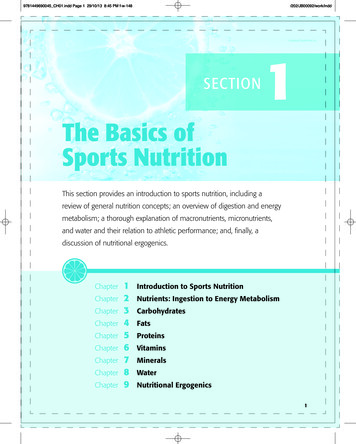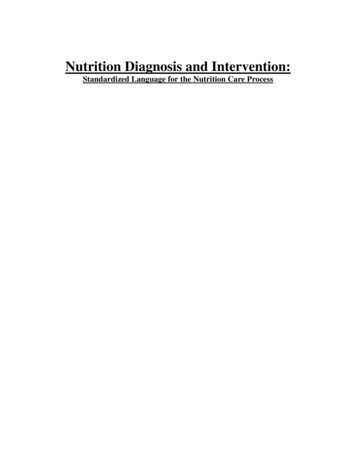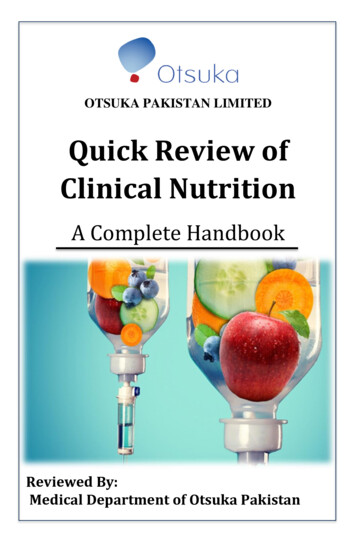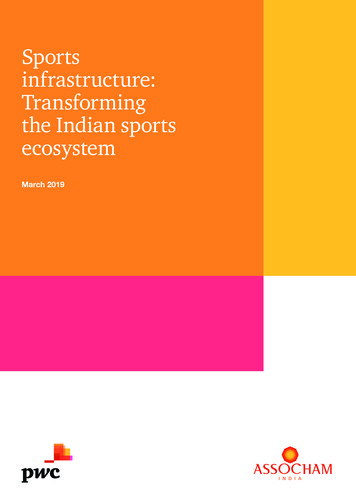
Transcription
Guest et al. Journal of the International Society of Sports 4(2021) 18:1REVIEWOpen AccessInternational society of sports nutritionposition stand: caffeine and exerciseperformanceNanci S. Guest1* , Trisha A. VanDusseldorp2, Michael T. Nelson3, Jozo Grgic4, Brad J. Schoenfeld5,Nathaniel D. M. Jenkins6, Shawn M. Arent7,8, Jose Antonio9, Jeffrey R. Stout10, Eric T. Trexler11,Abbie E. Smith-Ryan12, Erica R. Goldstein10, Douglas S. Kalman13,14 and Bill I. Campbell15AbstractFollowing critical evaluation of the available literature to date, The International Society of Sports Nutrition (ISSN)position regarding caffeine intake is as follows:1. Supplementation with caffeine has been shown to acutely enhance various aspects of exercise performancein many but not all studies. Small to moderate benefits of caffeine use include, but are not limited to: muscularendurance, movement velocity and muscular strength, sprinting, jumping, and throwing performance, as well asa wide range of aerobic and anaerobic sport-specific actions.2. Aerobic endurance appears to be the form of exercise with the most consistent moderate-to-large benefitsfrom caffeine use, although the magnitude of its effects differs between individuals.3. Caffeine has consistently been shown to improve exercise performance when consumed in doses of 3–6 mg/kg body mass. Minimal effective doses of caffeine currently remain unclear but they may be as low as 2 mg/kgbody mass. Very high doses of caffeine (e.g. 9 mg/kg) are associated with a high incidence of side-effects anddo not seem to be required to elicit an ergogenic effect.4. The most commonly used timing of caffeine supplementation is 60 min pre-exercise. Optimal timing ofcaffeine ingestion likely depends on the source of caffeine. For example, as compared to caffeine capsules,caffeine chewing gums may require a shorter waiting time from consumption to the start of the exercisesession.5. Caffeine appears to improve physical performance in both trained and untrained individuals.6. Inter-individual differences in sport and exercise performance as well as adverse effects on sleep or feelings ofanxiety following caffeine ingestion may be attributed to genetic variation associated with caffeine metabolism,and physical and psychological response. Other factors such as habitual caffeine intake also may play a role inbetween-individual response variation.7. Caffeine has been shown to be ergogenic for cognitive function, including attention and vigilance, in most(Continued on next page)* Correspondence: nanci.guest@mail.utoronto.ca1Department of Nutritional Sciences, Faculty of Medicine, University ofToronto, 1 King’s College Circle, Room 5326A, Toronto, ON M5S 1A8, CanadaFull list of author information is available at the end of the article The Author(s). 2021 Open Access This article is licensed under a Creative Commons Attribution 4.0 International License,which permits use, sharing, adaptation, distribution and reproduction in any medium or format, as long as you giveappropriate credit to the original author(s) and the source, provide a link to the Creative Commons licence, and indicate ifchanges were made. The images or other third party material in this article are included in the article's Creative Commonslicence, unless indicated otherwise in a credit line to the material. If material is not included in the article's Creative Commonslicence and your intended use is not permitted by statutory regulation or exceeds the permitted use, you will need to obtainpermission directly from the copyright holder. To view a copy of this licence, visit http://creativecommons.org/licenses/by/4.0/.The Creative Commons Public Domain Dedication waiver ) applies to thedata made available in this article, unless otherwise stated in a credit line to the data.
Guest et al. Journal of the International Society of Sports Nutrition(2021) 18:1Page 2 of 37(Continued from previous page)individuals.8. Caffeine may improve cognitive and physical performance in some individuals under conditions of sleepdeprivation.9. The use of caffeine in conjunction with endurance exercise in the heat and at altitude is well supported whendosages range from 3 to 6 mg/kg and 4–6 mg/kg, respectively.10. Alternative sources of caffeine such as caffeinated chewing gum, mouth rinses, energy gels and chews havebeen shown to improve performance, primarily in aerobic exercise.11. Energy drinks and pre-workout supplements containing caffeine have been demonstrated to enhance bothanaerobic and aerobic performance.IntroductionCaffeine is the world’s most widely consumed psychoactive substance and naturally occurs in dozens of plantspecies, including coffee, tea and cocoa. Caffeine isingested most frequently in the form of a beverage suchas coffee, soft drinks and tea, although the consumptionof many functional beverages, such as energy drinks, hasbeen on a steady rise in the past two decades [1]. InWestern countries, approximately 90% of adults consume caffeine on a regular basis, with dietary caffeineconsumption of U.S. adult men and women estimated atapproximately 200 mg/day in a 2009–2010 survey [2–4].In young adults and exercising individuals, there has alsobeen a rise in the consumption of other caffeinecontaining products, including energy drinks [1, 3], ‘preworkout supplements’, chewing gum, energy gels andchews, aerosols, and many other novel caffeinated foodproducts [5]. Caffeine-containing products have a rangeof doses per serving, from 1 mg in milk chocolate up to 300 mg in some dietary supplements [6].Caffeine and its effects on health have been a longstanding topic of interest, and caffeine continues to be adietary compound of concern in public health, as indicated by extensive investigations [7–10]. At the sametime, caffeine has become ubiquitous in the sportingworld, where there is keen interest in better understanding the impact of caffeine on various types of exerciseperformance. Accordingly, caffeine has dominated theergogenic aids and sport supplement research domainover the past several decades [11–13].Caffeine in sport: a brief historyIn the early days (1900s) of modern sport, concoctionsof plant-based stimulants, including caffeine and othercompounds such as cocaine, strychnine, ether, heroinand nitroglycerin, were developed secretly by trainers,athletes and coaches, in what appears to be evidence forearly day ergogenic aids designed to provide a competitive advantage [14]. The use of various pharmaceuticalcocktails by endurance athletes continued until heroinand cocaine became restricted to prescriptions in the1920s, and further when the International OlympicCommittee (IOC) introduced anti-doping programs inthe late 1960s [15].Some of the earliest published studies on caffeinecame from two psychologists and colleagues WilliamRivers and Harald Webber, at Cambridge University,who both had an interest in disentangling the psychological and physiological effects of substances like caffeine and alcohol. Rivers and Webber, using themselvesas subjects, investigated the effects of caffeine on musclefatigue. The remarkable well-designed studies carriedout from 1906 to 1907 used double-blinded placebocontrolled trials and standardization for diet (i.e. caffeine, alcohol), and were described in a 1907 paper inthe Journal of Physiology [16]. Significant research onthe effects of caffeine on exercise performance withmore subjects, different sports, and exploring variablessuch as the effects between trained and untrained individuals, began and continued through the 1940s [14, 17].However, it was the series of studies investigating thebenefits of caffeine in endurance sports in the HumanPerformance Laboratory at Ball State University in thelate 1970s, led by David Costill [18, 19] and others [20],that sparked a generation of research on the effects ofcaffeine in exercise metabolism and sports performance.Caffeine sourcesAlong with naturally occurring sources, such as coffee,tea and cocoa, caffeine is also added to many foods, beverages and novelty products, such as jerky, peanut butter, and candy, in both synthetic (e.g. powder) andnatural (e.g. guarana, kola nut) forms. Synthetic caffeineis also an ingredient in several over-the-counter and prescription medications, as it is often used in combinationwith analgesic and diuretic drugs to amplify theirpharmacological potency [21].Approximately 96% of caffeine consumption from beverages comes from coffee, soft drinks and tea [22]. Additionally, there are varying levels of caffeine in the beans,leaves and fruit of more than 60 plants, resulting in greatinterest in herbal and other plant-based supplements
Guest et al. Journal of the International Society of Sports Nutrition[23–26]. Caffeine-containing energy drink consumption[27–31] and co-ingestion of caffeine with (e.g. “preworkouts”), or in addition to, other supplements (e.g. caffeine creatine) is also popular among exercising individuals [32–39]. To date, the preponderance of caffeine andexercise performance literature has utilized anhydrous caffeine (in a capsule) [40–46] for simpler dosestandardization and placebo creation. There is also agrowing body of literature studying the effects of using alternate delivery methods of caffeine during exercise [5]such as coffee [18, 47–56], energy drinks, herbal formulas[57] and ‘pre-workout’ formulas, among others. A reviewof alternate caffeine forms may be found in the Alternativecaffeine sources section and Tables 4, 5, 6, 7 and 8.Caffeine legality in sportAnti-doping rules apply to most sports, especially inthose where athletes are competing at national andinternational levels. The IOC continues to recognize thatcaffeine is frequently used by athletes because of its reported performance-enhancing or ergogenic effects[109]. Caffeine was added to the list of banned substances by the IOC in 1984 and the World Anti-DopingAgency (WADA) in 2000. A doping offense was definedas having urinary caffeine concentrations exceeding acut-off of 15 μg/ml. In 1985, the threshold was reducedto 12 μg/ml [110]. The cut-off value was chosen to exclude typical amounts ingested as part of common dietary or social coffee drinking patterns, and todifferentiate it from what was considered to be an aberrant use of caffeine for the purpose of sports performance enhancement [111].The IOC and WADA removed the classification ofcaffeine as a “controlled” substance in 2004, leading to arenewed interest in the use of caffeine by athletes. However, caffeine is still monitored by WADA, and athletesare encouraged to maintain a urine caffeine concentration below the limit of 12 μg/ml urine which corresponds to 10 mg/kg body mass orally ingested overseveral hours, and which is more than triple the intakereported to enhance performance [112, 113]. Interestingly, caffeine is also categorized as a banned substanceby the National Collegiate Athletic Association (NCAA),if urinary caffeine concentration exceeds 15 μg/ml,which is greater than the “monitored substance” level setfor WADA [114], and also well above amounts that aredeemed ergogenic.A comparison of caffeine concentrations obtained during in-competition doping control from athletes in several sports federations pre 2004 versus post-2004,indicated that average caffeine concentrations decreasedin 2004 after removal from the prohibited substance list[110]. Reports on over 20,000 urine samples collectedand analyzed after official national and international(2021) 18:1Page 3 of 37competitions between 2004 and 2008, and again in 2015using 7500 urine samples found overall prevalence ofcaffeine use across various sports to be about 74% in the2004 to 2008 time period and roughly 76% in 2015. Thehighest use of caffeine was among endurance athletes inboth studies [115, 116]. Urinary caffeine concentrationsignificantly increased from 2004 to 2015 in athletics,aquatics, rowing, boxing, judo, football, and weightlifting; however, the sports with the highest urine caffeineconcentration in 2015 were cycling, athletics, and rowing[116].Caffeine pharmacokineticsCaffeine or 1,3,7-trimethylxanthine, is an odorless whitepowder that is soluble in both water and lipids and has abitter taste. It is rapidly absorbed from the gastrointestinal tract, mainly from the small intestine but also inthe stomach [117]. In saliva, caffeine concentrationreaches 65–85% of plasma levels, and is often used tonon-invasively monitor compliance for ingestion or abstinence of caffeine [118]. Caffeine is effectively distributed throughout the body by virtue of being sufficientlyhydrophobic to allow easy passage through most, if notall biological membranes, including the blood-brain barrier [119]. When caffeine is consumed it appears in theblood within minutes, with peak caffeine plasma concentrations after oral administration reported to occur attimes (Tmax) ranging from 30 to 120 min [43, 120–122].The absolute bioavailability of caffeine is very high andreaches near 100% as seen in studies reporting areasunder the plasma concentration-time curves (AUC)[120]. Once caffeine is absorbed, there appears to be nohepatic first-pass effect (i.e., the liver does not appear toremove caffeine as it passes from the gut to the generalcirculation), as evidenced by similar plasma concentration curves when administered by either oral or intravenous routes [123]. Caffeine absorption from food andbeverages does not seem to be dependent on age, gender, genetics or disease, or the consumption of drugs, alcohol or nicotine. However, the rates of caffeinemetabolism and breakdown appear to differ between individuals through both environmental and genetic influences [3, 124, 125].Over 95% of caffeine is metabolized in the liver by theCytochrome P450 1A2 (CYP1A2) enzyme, a member ofthe cytochrome P450 mixed-function oxidase system,which metabolizes and detoxifies xenobiotics in the body[126]. CYP1A2 catalyzes the demethylation of caffeineinto the primary metabolites paraxanthine (1,7-dimethylxanthine), theobromine (3,7-dimethylxanthine) andtheophylline (1,3-dimethylxanthine), which account forapproximately 84, 12, and 4%, of total caffeine elimination, respectively [127, 128]. These three caffeine metabolites undergo further demethylations and oxidation
Guest et al. Journal of the International Society of Sports Nutritionto urates in the liver with about 3–5% remaining in caffeine form when excreted in the urine [129, 130]. Whilethe average half-life (t1/2) of caffeine is generally reportedto be between 4 and 6 h, it varies between individualsand even may range from 1.5 to 10 h in adults [120].The wide range of variability in caffeine metabolism isdue to several factors. The rate of caffeine metabolismmay be inhibited or decreased with pregnancy or use ofhormonal contraceptives [125], increased or induced byheavy caffeine use [131] cigarette smoking [132] ormodified in either direction by certain dietary factors[133] and/or variation in the CYP1A2 gene, which willbe discussed later [125, 132–134].Several studies have also shown that the form of caffeine or its vehicle for entry into the body can modifythe pharmacokinetics [58, 81, 119, 122]. One small trial(n 3) evaluated Tmax for a variety of beverages that allincluded 160 mg of caffeine but in different volumes ofsolution, and reported that Tmax occurs at 0.5, 0.5, and2 h for coffee, tea and cola, respectively [135]. In anotherstudy involving seven participants, caffeine plasma concentrations peaked rapidly at 30 min for capsule form,whereas caffeine absorption from cola and chocolate wasdelayed and produced lower plasma concentrations thatpeaked at roughly 90–120 min after consumption. Thisstudy also did not control for volume of administeredsolution (capsules and chocolate ingested with 360 mlwater and 800 ml cola) [122]. Liguori et al. [136] evaluated a 400 mg dose of caffeine in 13 subjects and reported salivary caffeine Tmax values of 42, 39 and 67min, for coffee, sugar-free cola and caffeine capsules, respectively. However, fluid volume was again not standardized (coffee – 12 oz., sugar-free cola – 24 oz.,capsules – volume of administered fluid not reported).The impact of temperature or rate of ingestion of caffeine has also been investigated, amidst concerns thatcold energy drinks might pose a danger when chuggedquickly, compared to sipping hot coffee. One study [121]compared five conditions that included: slow ingestion(20 min) of hot coffee, and fast (2-min) or slow (20-min)ingestion for both cold coffee and energy drinks. Similarto other caffeine pharmacokinetic studies [122, 135],White et al. [121] reported that although the rate of consumption, temperature, and source (coffee vs. energydrink) may be associated with slight differences in pharmacokinetic activity, these differences are small.Chewing gum formulations appear to alter pharmacokinetics, as much of the caffeine released from the gumthrough mastication can be absorbed via the buccal cavity, which is considered faster due to its extensivevascularization, especially for low molecular weighthydrophobic agents [137]. Kamimori et al. [58] compared the rate of absorption and relative caffeine bioavailability from chewing gum compared to a capsule(2021) 18:1Page 4 of 37form of caffeine. Although caffeine administered in thechewing gum formulation was absorbed at a significantlyfaster rate, the overall bioavailability was comparable tothe capsuled 100 and 200 mg caffeine dose groups.These pharmacokinetic findings are useful for militaryand sport purposes, where there is a requirement forrapid and maintained stimulation over specific periodsof time. Chewing gum may also be advantageous due toreduced digestive requirements, where absorption of caffeine in other forms (capsule, coffee etc.) may be hindered by diminished splanchnic blood flow duringmoderate to intense exercise. Finally, there is a growingprevalence of caffeinated nasal and mouth aerosols administered directly in the mouth, under the tongue orinspired may affect the brain more quickly through several proposed mechanisms [5], although there are only afew studies to date to support this claim. The administration of caffeine via aerosol into the oral cavity appearsto produce a caffeine pharmacokinetic profile comparable to the administration of a caffeinated beverage [81].Nasal and mouth aerosols will be discussed further inanother section.Mechanism of Action (MOA)Although the action of caffeine on the central nervoussystem (CNS) has been widely accepted as the primarymechanism by which caffeine alters performance, severalmechanisms have been proposed to explain the ergogenic effects of caffeine, including increased myofibrillarcalcium availability [138, 139], optimized exercise metabolism and substrate availability [45], as well as stimulation of the CNS [140–142]. One of the earlierproposed mechanisms associated with the ergogenic effects of caffeine stemmed from the observed adrenaline(epinephrine)-induced enhanced free-fatty acid (FFA)oxidation after caffeine ingestion and consequent glycogen sparing, resulting in improved endurance performance [18, 45, 143]. However, this substrate-availabilityhypothesis was challenged and eventually dismissed,where after several performance studies it became clearthat the increased levels of FFAs appeared to be higherearlier in exercise when increased demand for fuel viafat oxidation would be expected [141, 144, 145]. Furthermore, this mechanism could not explain the ergogeniceffects of caffeine in short duration, high-intensity exercise in which glycogen levels are not a limiting factor.Importantly, several studies employing a variety of exercise modalities and intensities failed to show a decreasein respiratory exchange ratio (RER) and/or changes inserum FFAs, which would be indicative of enhanced fatmetabolism during exercise when only water wasingested [144, 146–148]. Ingestion of lower doses of caffeine (1–3 mg/kg of body mass), which do not result insignificant physiological responses (i.e. RER, changes in
Guest et al. Journal of the International Society of Sports Nutritionblood lactate, glucose), also appear to deliver measurableergogenic effects, offering strong support for the CNS asthe origin of reported improvements [43, 149, 150]. Assuch, focus has shifted to the action of caffeine duringexercise within the central and peripheral nervous systems, which could alter the rate of perceived exertion(RPE) [151–154], muscle pain [151, 155–157], and possibly the ability of skeletal muscle to generate force[151].Caffeine does appear to have some direct effects onmuscle which may contribute to its ergogenicity. Themost likely pathway that caffeine may benefit musclecontraction is through calcium ion (Ca2 ) mobilization,which facilitates force production by each motor unit[138, 139, 150, 158]. Fatigue caused by the gradual reduction of Ca2 release may be attenuated after caffeineingestion [139, 159]. Similarly, caffeine may work, inpart, in the periphery through increased sodium/potassium (Na /K ) pump activity to potentially enhanceexcitation-contraction coupling necessary for musclecontraction [160]. Caffeine appears to employ its effectsat various locations in the body, but the most robust evidence suggests that the main target is the CNS, which isnow widely accepted as the primary mechanism bywhich caffeine alters mental and physical performance[141]. Caffeine is believed to exert its effects on the CNSvia the antagonism of adenosine receptors, leading to increases in neurotransmitter release, motor unit firingrates, and pain suppression [151, 155–157, 161]. Thereare four distinct adenosine receptors, A1, A2A, A2B andA3, that have been cloned and characterized in severalspecies [162]. Of these subtypes, A1 and A2A, which arehighly concentrated in the brain, appear to be the maintargets of caffeine [163]. Adenosine is involved in numerous processes and pathways, and plays a crucial roleas a homeostatic regulator and neuromodulator in thenervous system [164]. The major known effects of adenosine are to decrease the concentration of many CNSneurotransmitters, including serotonin, dopamine,acetylcholine, norepinephrine and glutamate [163–165].Caffeine, which has a similar molecular structure to adenosine, binds to adenosine receptors after ingestion andtherefore increases the concentration of these neurotransmitters [163, 165]. This results in positive effects onmood, vigilance, focus, and alertness in most, but not all,individuals [166, 167].Researchers have also characterized aspects of adenosine A2A receptor function related to cognitive processes[168] and motivation [169, 170]. In particular, severalstudies have focused on the functional significance ofadenosine A2A receptors and the interactions betweenadenosine and dopamine receptors, in relation to aspectsof behavioral activation and effort-related processes[168–171]. The serotonin receptor 2A (5-HT2A) has(2021) 18:1Page 5 of 37also been shown to modulate dopamine release, throughmechanisms involving regulation of either dopaminesynthesis or dopaminergic neuron firing rate [172, 173].Alterations in 5-HTR2A receptors may therefore affectdopamine release and upregulation of dopamine receptors [174, 175]. A possible mechanism for caffeine’sergogenicity may involve variability in 5-HTR2A receptor activity, which may modulate dopamine release andconsequently impact alertness, pain and motivation andeffort [141]. 5-HTR2A receptors are encoded by theHTR2A gene, which serves as a primary target for serotonin signaling [176], and variations in the gene havebeen shown to affect 5-HTR2A receptor activity [177,178]. This may therefore modulate dopamine activity,which may help to elucidate some of the relationshipsamong neurotransmitters, genetic variation and caffeineresponse, and the subsequent impact on exerciseperformance.Muscle pain has been shown to negatively affect motorunit recruitment and skeletal muscle force generationproportional to the subjective scores for pain intensity[179, 180]. In one study, progressively increased musclepain intensity caused a gradual decrease in motor firingrates [179]. However, this decrease was not associatedwith a change in motor unit membrane properties demonstrating a central inhibitory motor control mechanismwith effects correlated to nociceptive activity [179].Other studies also indicate that muscle force inhibitionby muscle pain is centrally mediated [181]. Accordingly,caffeine-mediated CNS mechanisms, such as dopaminerelease [182], are likely imputable for pain mitigationduring high-intensity exercise [155–157, 181, 183–186].Although there appears to be strong evidence supportingthe analgesic effects of caffeine during intense exercise,others have found no effect [185, 187].The attenuation of pain during exercise as a result ofcaffeine supplementation may also result in a decreasein the RPE during exercise. Two studies [183, 184] havereported that improvements in performance were accompanied by a decrease in pain perception as well as adecrease in RPE under caffeine conditions, but it is unclear which factor may have contributed to the ergogenic effect. Acute caffeine ingestion has been shown toalter RPE, where effort may be greater under caffeineconditions, yet it is not perceived as such [12, 152–154].A meta-analysis [12] identified 21 studies using mostlyhealthy male subjects (74%) between the ages of 20 and35 years and showed a 5.6% reduction in RPE during exercise following caffeine ingestion. An average improvement in performance of 11% was reported across allexercise modalities. This meta-analysis established thatreductions in RPE explain up to 29% of the variance inthe improvement in exercise performance [12]. Othershave not found changes in RPE with caffeine use [187].
Guest et al. Journal of the International Society of Sports NutritionA more recent study by Green et al. [188] also showedthat when subjects were instructed to cycle at specificRPE (effort) levels under caffeine conditions, the higherperceived intensity did not necessarily result in greaterwork and improved performance in all subjects equally.The authors noted that individual responses to caffeinemight explain their unexpected findings.In the last decade, our understanding of CNS fatiguehas improved. Historically, it is well- documented that“psychological factors” can affect exercise performanceand that dysfunction at any step in the continuum fromthe brain to the peripheral contractile machinery will result in muscular fatigue [189, 190]. The role of the CNSand its ‘motor drive’ effect was nicely shown by Daviset al. [191] who examined the effect of caffeine injecteddirectly into the brains of rats on their ability to run toexhaustion on a treadmill. In this controlled study, ratswere injected with either vehicle (placebo), caffeine, 5′N-Ethylcarboxamido adenosine (NECA), an adenosinereceptor agonist, or caffeine NECA together. Rats ran80 min in the placebo trial, 120 min in the caffeine trialand only 25 min with NECA. When caffeine and NECAwere given together, the effects appeared to cancel eachother out, and run time was similar to placebo. Whenthe study was repeated with peripheral intraperitoneal(body cavity) injections instead of brain injections, therewas no effect on run performance. The authors concluded that caffeine increased running time by delayingfatigue through CNS effects, in part by blocking adenosine receptors [191]. Caffeine also appears to enhancecognitive performance more in fatigued than well-restedsubjects [192–194]. This phenomenon is also apparentin exercise performance [195] both in the field [196] andin the lab [60, 63, 149].The placebo effectThe placebo effect is a beneficial outcome that cannotbe attributed to a treatment or intervention but isbrought about by the belief that one has received a positive intervention. For example, an individual may ingesta capsule with sugar or flour (a small amount of nonactive ingredient) but believes that he/she ingested caffeine and experiences improvements in performance because of this belief [197]. The nocebo effect is directlyopposite to this in that a negative outcome occurs following the administration of an intervention or lack ofan intervention (e.g. knowingly ingesting a placebo)[198]. For example, the nocebo may be a substance without medical effects, but which worsens the health statusof the person taking it by the negative beliefs and expectations of the patient. Similarly, the nocebo may be a‘caffeine placebo’, where an individual’s performance isworse based on the belief that they did not ingestcaffeine.(2021) 18:1Page 6 of 37Several studies have provided evidence for placebo effects associated with caffeine ingestion [199–201] orother “beneficial” interventions [202] during exercise. Anexample of this was reported in a study [200] wherewell-trained cyclists exhibited a linear dose–response relationship in experimental trials from baseline to a moderate (4.5 mg/kg) and high dose (9 mg/kg) of caffeinerespectively. Athletes improved as the perceived caffeinedoses increased; however, a placebo was used in all interventions. Similarly, Saunders et al. [201] found thatcorrect identification of caffeine appears to improve cycling performance to a greater extent than the overall effect of caffeine, where participants who correctlyidentified placebo showed possible harmful effects onperformance. Therefore, readers are encouraged to consider whether studies that have explored the effects ofcaffeine on exercise have examined and reported the efficacy of the blinding of the participants.Caffeine and endurance exerciseLess than a 1% change in average speed is enough toaffect medal rankings in intense Olympic enduranceevents lasting 45 s to 8 min [203]. In other events, suchas the men’s individual
1920s, and further when the International Olympic Committee (IOC) introduced anti-doping programs in the late 1960s [15]. Some of the earliest published studies on caffeine came from two psychologists and colleagues William Rivers and Harald Webber, at Cambridge University, who both had an interest in disentangling the psycho-

